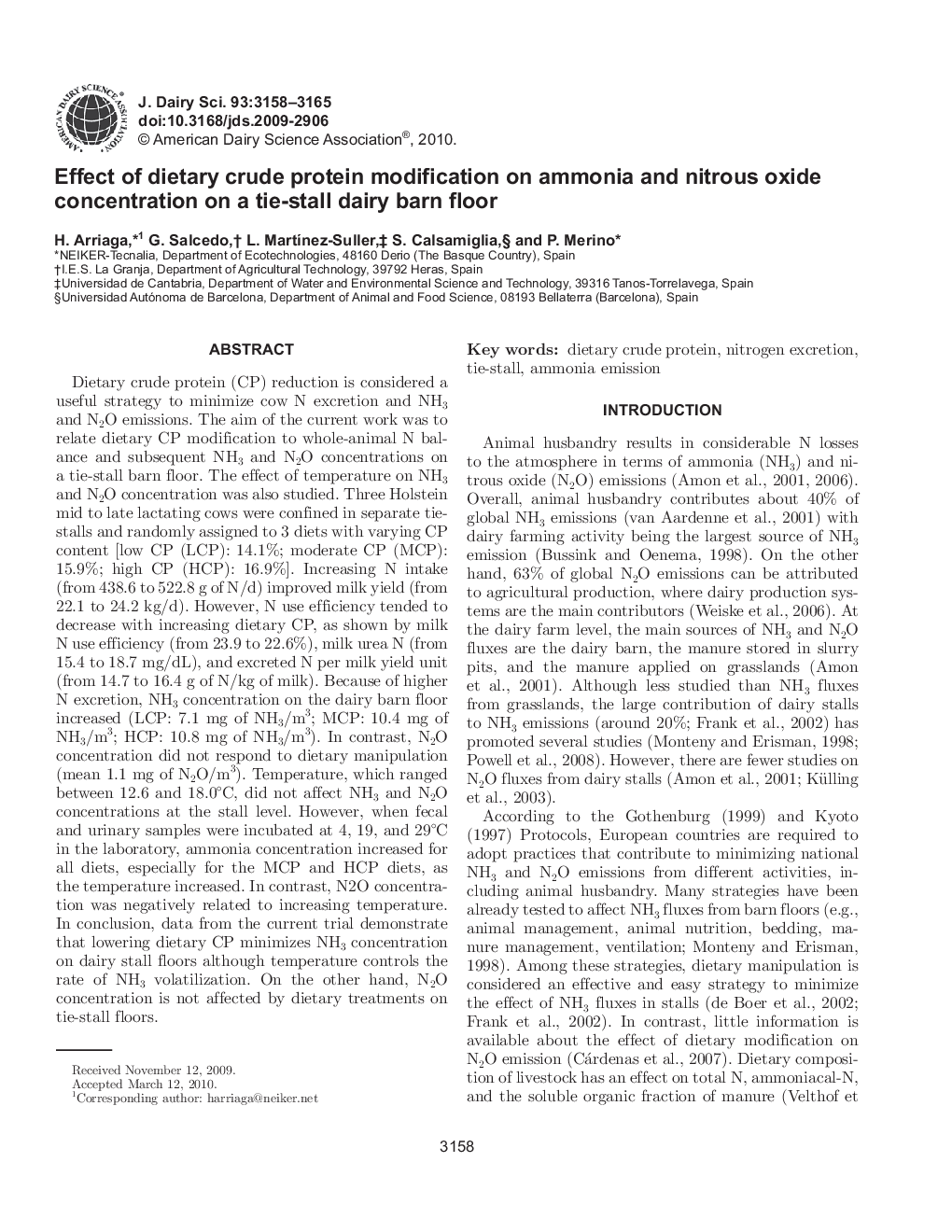| کد مقاله | کد نشریه | سال انتشار | مقاله انگلیسی | نسخه تمام متن |
|---|---|---|---|---|
| 10981552 | 1108077 | 2010 | 8 صفحه PDF | دانلود رایگان |
عنوان انگلیسی مقاله ISI
Effect of dietary crude protein modification on ammonia and nitrous oxide concentration on a tie-stall dairy barn floor
دانلود مقاله + سفارش ترجمه
دانلود مقاله ISI انگلیسی
رایگان برای ایرانیان
کلمات کلیدی
موضوعات مرتبط
علوم زیستی و بیوفناوری
علوم کشاورزی و بیولوژیک
علوم دامی و جانورشناسی
پیش نمایش صفحه اول مقاله

چکیده انگلیسی
Dietary crude protein (CP) reduction is considered a useful strategy to minimize cow N excretion and NH3 and N2O emissions. The aim of the current work was to relate dietary CP modification to whole-animal N balance and subsequent NH3 and N2O concentrations on a tie-stall barn floor. The effect of temperature on NH3 and N2O concentration was also studied. Three Holstein mid to late lactating cows were confined in separate tie-stalls and randomly assigned to 3 diets with varying CP content [low CP (LCP): 14.1%; moderate CP (MCP): 15.9%; high CP (HCP): 16.9%]. Increasing N intake (from 438.6 to 522.8 g of N/d) improved milk yield (from 22.1 to 24.2 kg/d). However, N use efficiency tended to decrease with increasing dietary CP, as shown by milk N use efficiency (from 23.9 to 22.6%), milk urea N (from 15.4 to 18.7 mg/dL), and excreted N per milk yield unit (from 14.7 to 16.4 g of N/kg of milk). Because of higher N excretion, NH3 concentration on the dairy barn floor increased (LCP: 7.1 mg of NH3/m3; MCP: 10.4 mg of NH3/m3; HCP: 10.8 mg of NH3/m3). In contrast, N2O concentration did not respond to dietary manipulation (mean 1.1 mg of N2O/m3). Temperature, which ranged between 12.6 and 18.0°C, did not affect NH3 and N2O concentrations at the stall level. However, when fecal and urinary samples were incubated at 4, 19, and 29°C in the laboratory, ammonia concentration increased for all diets, especially for the MCP and HCP diets, as the temperature increased. In contrast, N2O concentration was negatively related to increasing temperature. In conclusion, data from the current trial demonstrate that lowering dietary CP minimizes NH3 concentration on dairy stall floors although temperature controls the rate of NH3 volatilization. On the other hand, N2O concentration is not affected by dietary treatments on tie-stall floors.
ناشر
Database: Elsevier - ScienceDirect (ساینس دایرکت)
Journal: Journal of Dairy Science - Volume 93, Issue 7, July 2010, Pages 3158-3165
Journal: Journal of Dairy Science - Volume 93, Issue 7, July 2010, Pages 3158-3165
نویسندگان
H. Arriaga, G. Salcedo, L. MartÃnez-Suller, S. Calsamiglia, P. Merino,